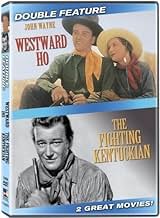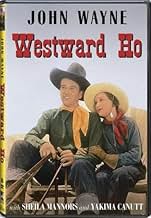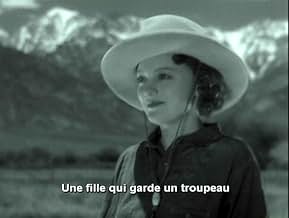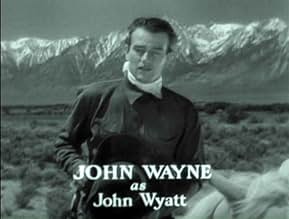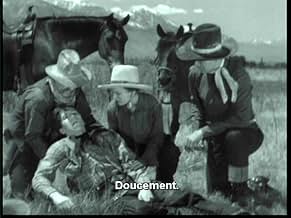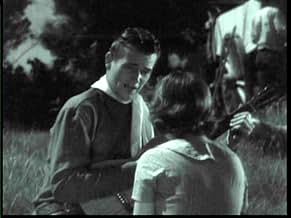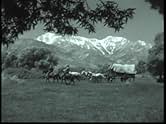Ajouter une intrigue dans votre langueAs a youngster John Wyatt saw his parents killed and his brother kidnapped. On a wagon train heading West he meets his brother who is now a spy for the gang which originally did the dirty wo... Tout lireAs a youngster John Wyatt saw his parents killed and his brother kidnapped. On a wagon train heading West he meets his brother who is now a spy for the gang which originally did the dirty work. He and his brother both fall for Mary Gordon.As a youngster John Wyatt saw his parents killed and his brother kidnapped. On a wagon train heading West he meets his brother who is now a spy for the gang which originally did the dirty work. He and his brother both fall for Mary Gordon.
- Réalisation
- Scénario
- Casting principal
- Mary Gordon
- (as Sheila Mannors)
- Lafe Gordon
- (as James Farley)
- Townsman
- (non crédité)
- Singing Rider
- (non crédité)
- Vigilante
- (non crédité)
- Vigilante
- (non crédité)
- State Official
- (non crédité)
Avis à la une
In 1935, the Lone Star unit was sold by Monogram to the fledgling Republic Pictures, who gave producer Paul Malvern a bigger budget to work with and it really shows.
While this has basically the same formula as Wayne's earlier work for Lone Star, the production values are far greater, with some really nice photography, excellent locations, and a nice little stunt-filled finale. It's always good to see Glenn Strange play a good guy too.
Thrown in are some decent songs, including another odd lip-sync performance from the Duke. Also pretty goofy is the dedication at the beginning of the movie, a salute to the vigilantes of the old west!
Ever since his ill-fated lead role in Raoul Walsh's big-budgeted 1930 epic "The Big Trail," Wayne was relegated to either tiny parts in major feature films or starred in Poverty Row films. Small studios such as Monogram Pictures loved his reasonable salary, his large physique and his Western-style mannerisms. In the stretch between 1930 and 1939 Wayne played in over 80 so-called 'horse operas.' The frequency appearing before the camera refined his acting skills, making him more polished with his every movie. Wayne also became adept at riding horses and in his stunt work, especially in his fist fighting. He was tutored by stuntman Yakima Canutt, a pioneer in making knuckle confrontations more realistic before the camera--yet insuring the safety of the actors. Wayne developed a style unique in cinema at the time; he's not only shown throwing punches with his patented wide swings, but he used every known tactic to fight the bad guys. "Before I came along, it was standard practice that the hero must always fight clean," Wayne said. "The heavy was allowed to hit the hero in the head with a chair or throw a kerosene lamp at him or kick him in the stomach, but the hero could only knock the villain down politely and then wait until he rose. I changed all that. I threw chairs and lamps. I fought hard and I fought dirty. I fought to win." In "Westward Ho," a gang of outlaws come across a small wagon train with a herd of cattle. The cow wrestlers kill its members and steal the livestock. One youngster, Jim (Frank McGlynn, Jr. As an adult) is kidnapped while his brother John (Wayne as an adult), is left for dead-but survives. As he grows into adulthood, John vows vengeance on those killers, while unbeknownst to him his brother Jim becomes part of the gang. The movie has been cited by some as cinema's earliest revisionist Western where the actions of John crosses the line employing dirty tactics in the name of seeking revenge.
Hollywood's landscape was dotted with a number of struggling independent film companies scratching out a living producing low-budget movies. Film lab owner Herbert Yates, an original investor in 20th Century Pictures, had a number of small studios in debt to his company from processing their film. Yates came up with the idea of merging six of these indebted studios into one larger company. He encouraged the consolidation by threatening them to immediately pay their bills. Most agreed, and the new studio became Republic Pictures. Those that merged included Monogram Pictures, which produced Wayne's westerns and possessed a nationwide distribution system Yates could use. Mascot Pictures Corp. Was the most sophisticated studio of the bunch, owning Mack Sennett's former facilities in Studio City as well as having Gene Autry under contract. Majestic Pictures, Liberty Pictures and Chesterfield Pictures rounded out the remaining studios joining Republic.
Through the years, Republic Pictures competed with the big boys, not only locking in contracts with the likes of Wayne, Autry and Roy Rogers, but produced bigger budgeted movies such as 1949's "Sands of Iwo Jima," 1952's "The Quiet Man," and 1954's "Johnny Guitar."
Le saviez-vous
- AnecdotesJohn Wayne's singing voice is dubbed by Glenn Strange.
- GaffesThe handwriting on the notes that John Wyatt distributes varies between different notes.
- Citations
John Wyatt: [addressing potential recruits] And the answer, men is: we must band together. You, Carter; you, Russell; and every man here that's suffered from the injustice of these gangs. And it's up to us to clean them out. Now my plan is this: every man here will ride a white horse, wear a black shirt and a white scarf. And this way we'll know each other in battle. I'm asking for single men only. Men who'll stick. Who'll join me here?
- Crédits fousOpening titles: This picture is dedicated to the Vigilantes... builders of the New Empire of the West... stern frontiersmen of the days of '49. Men who gave their lives to purge the new frontier of lawlessness.
- ConnexionsFeatured in Kain's Lists: Top 12 Favorite Westerns (2013)
- Bandes originalesWestward Ho
(1935) (uncredited)
Written by Tim Spencer and Glenn Strange
Played and sung as background at the start
Reprised by The Arizona Wranglers as The Singing Riders
Played and sung as background at the end
Meilleurs choix
Détails
Box-office
- Budget
- 35 000 $US (estimé)
- Durée1 heure 1 minute
- Couleur
- Mixage
- Rapport de forme
- 1.37 : 1
Contribuer à cette page



